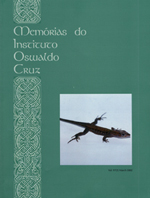
|
Memórias do Instituto Oswaldo Cruz
Fundação Oswaldo Cruz, Fiocruz
ISSN: 1678-8060
EISSN: 1678-8060
Vol. 113, No. 2, 2018, pp. 1-7
|
 Bioline Code: oc18017
Bioline Code: oc18017
Full paper language: English
Document type: Research Article
Document available free of charge
|
|
|
Memórias do Instituto Oswaldo Cruz, Vol. 113, No. 2, 2018, pp. 1-7
| en |
Increased thiol levels in antimony-resistant Leishmania infantum isolated from treatment-refractory visceral leishmaniasis in Brazil
Magalhães, Lucas S; Bomfim, Lays GS; Mota, Sthefanne G; Cruz, Geydson S; Corrêa, Cristiane B; Tanajura, Diego M; Lipscomb, Michael W; Borges, Valéria M; Jesus, Amélia R de; Almeida, Roque P de & Moura, Tatiana R de
Abstract
BACKGROUND Treatment-refractory visceral leishmaniasis (VL) has become an important problem in many countries.
OBJECTIVES We evaluated the antimony-resistance mechanisms of Leishmania infantum isolated from VL patients refractory or
responsive to treatment with pentavalent antimony.
METHODS Strains isolated from antimony-refractory patients (in vitro antimony-resistant isolates) and antimony-responsive
patients (in vitro antimony-sensitive isolates) were examined. Morphological changes were evaluated by transmission electron
microscopy after trivalent antimony exposure. P-glycoprotein (P-gp) efflux pump activity was evaluated using the pump-specific
inhibitor verapamil hydrochloride, and the role of thiol in trivalent antimony resistance was investigated using the enzymatic
inhibitor L-buthionine sulfoximine.
FINDINGS Antimony treatment induced fewer alterations in the cellular structure of L. infantum resistant isolates than in that
of sensitive isolates. P-gp efflux activity was not involved in antimony resistance in these isolates. Importantly, the resistant
isolates contained higher levels of thiol compared to the sensitive isolates, and inhibition of thiol synthesis in the resistant
isolates recovered their sensitivity to trivalent antimony treatment, and enhanced the production of reactive oxygen species in
promastigotes exposed to the drug.
MAIN CONCLUSIONS Our results demonstrate that isolates from patients with antimony-refractory VL exhibited higher thiol
levels than antimony-sensitive isolates. This indicates that redox metabolism plays an important role in the antimony-resistance
of New World VL isolates.
Keywords
Leishmania; visceral leishmaniasis; antimony; drug resistance
|
| |
© Copyright 2018 - Memórias do Instituto Oswaldo Cruz
Alternative site location: http://memorias.ioc.fiocruz.br
|
|
